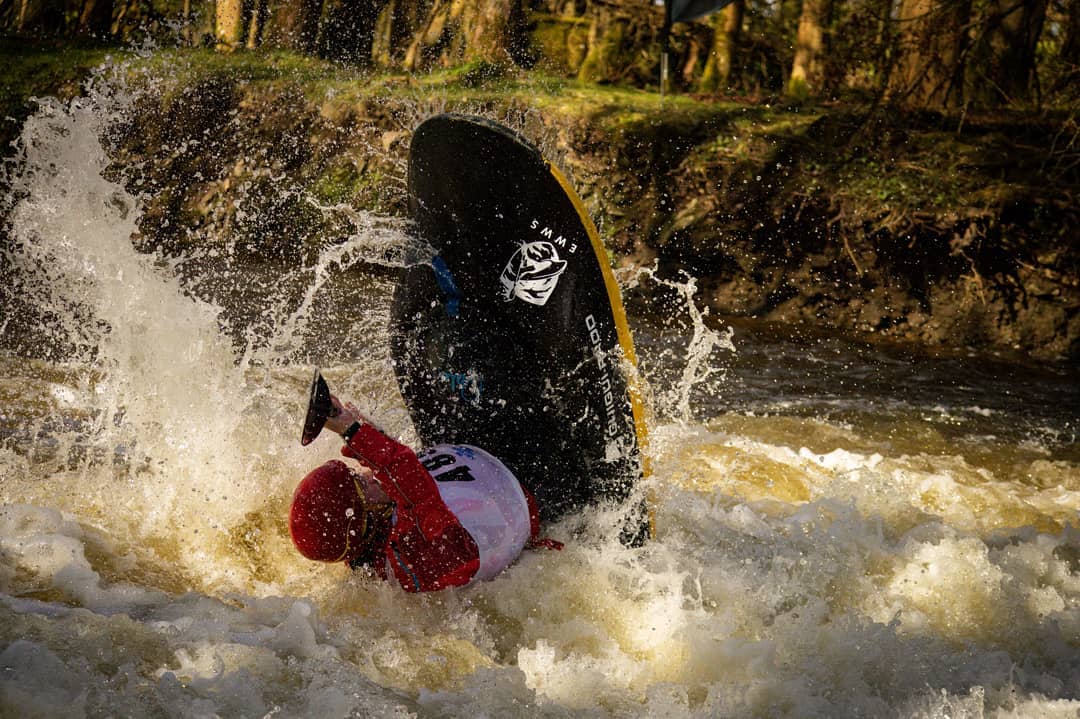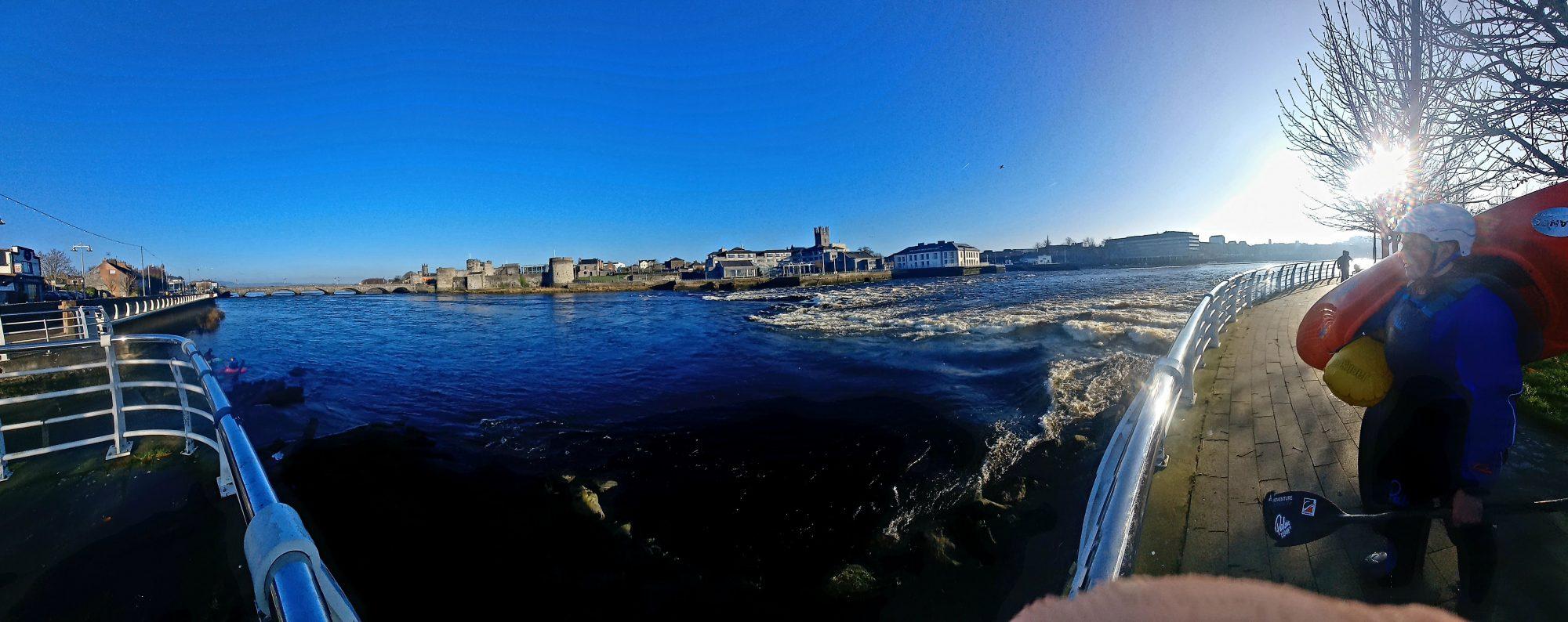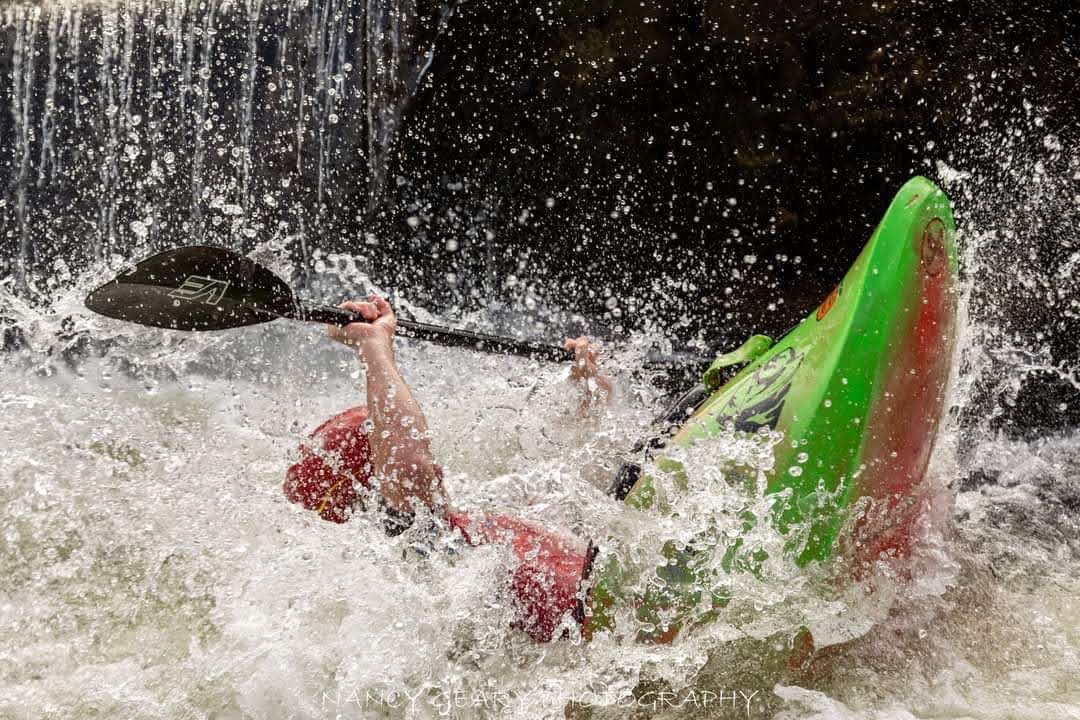Ireland is a playground for freestyle kayakers, with its breathtaking landscape and abundant rivers. Whether you’re a beginner or thrill seeking expert, Ireland has it all. So grab your boat, put your gear on and get surfing – here are some of my favourite rivers in Ireland for freestyle kayaking.
1/ River Liffey, County Dublin
The River Liffey sees a lot of kayakers take to her each week for various disciplines. The river has a series of weirs and rapids, culminating in two freestyle spots in the heart of Dubin. Sluice in Lucan and Parmhole in Palmerstown. They’re pretty close to each other on the river but Sluice has the longer reputation, as a fun wave with a history of developing lots of exciting Irish paddlers like the Kelleher brothers. Recently Parmhole, on the river just next to the Canoe Centre has become the hub of freestyle in Dublin. It’s a small Millau-esque hole that suits beginners and smaller paddlers. It’s a great spot to learn cartwheels and pirouettes.
Over the years the changing landscape of the Liffey has brought new features. Palmerstown weir used to have a great V-shaped wave that allowed all moves at the right level. Hopefully more play spots like this will appear in the future.
Sluice
For the Sluice, park here and walk up a few hundred meters just above the weir spanning the river. Follow the weir to river left to find the wave. (Beware of valuables being stolen from the car park!) Sluice is generally worth a trip as soon as Parmhole has washed-out (over 100 cm). It has changed significantly in recent years after the works done to rebuild the slalom course. Big eddies either side of the hole but it can be a busy spot as it is the training spot for the Irish slalom team and is regularly used by clubs.
- Between 8-20 cumecs (1-2.5 megs), it is a flushy hole that is fairly powerful with a very powerful pocket on surfers left. For aerial moves it is generally accepted that plugging surfers left and moving surfers right works best. 20 cumecs (2.5 megs) seems to be the sweet spot now.
- Between 21-24 cumecs (3 megs), the hole turns into a fairly messy wave. Many wave moves are possible but are hard to retain at the top end of this level.
- Above 28 cumecs (4 megs) Sluice is generally washed out. It is still possible to surf but extremely hard to retain most moves.
Parmhole
For Parmhole, park near the Canoe Centre store. There is a car park there and they often host events on the hole, but they’re open business hours and can be quite busy so a good bet is to park at the top of the lane and walk down. Parmhole is a low water feature which generally works from March to November but will work any time that Leixlip dam is releasing less than 8 cumecs (1 meg) and the river level is below 100 cm. Summer flows on the Liffey are normally 65 cm. Parmhole is in a quiet spot but can be busy on a sunny summer evening or at weekends. Plenty of eddy service and a great spot for beginners and improvers although a little shallow for those with a slow roll. The only spot in the country where you can get a coffee only twenty metres from the eddy!
- At 65 cm the hole ramp is steep, not very powerful and the pool is a little shallow.
- Between 65 and 75 cm the hole ramp is still quite steep but much more powerful. The pool is deeper and the feature is quite retentive.
- 75 to 85 cm is the sweet spot. The hole ramp is shallower but still retentive. Plenty of power and the pool is deep enough to not hit the bottom as long as you’re not plugging hard.
- Between 85 and 100 cm the hole gets less and less retentive but significantly more powerful. Lighter paddlers can continue to throw both hole and some wave moves at this level.
- Once the level goes over 100 cm the hole has pretty much washed out into a wave which is really nice in longer slicey boats but not much good in short boats.
- During the winter and periods of sustained rain when the level gets over 160 cm, two waves form, one on each side of the river. They are generally better in longer boats but the river right side is good in a short boat and most aerial moves seem to go well.
Parmhole gauge is here
Parmhole webcam is here
Special extra spot
The ‘Rye’ is well worth a trip once Sluice is flushed out. There needs to be plenty of rain but it does come up quickly so its generally a good bet during any sustained rainy periods. It is only five minutes up the road from sluice in Leixlip village. Above one metre on the gauge a river wide hole forms that gets better as the level increases. All hole moves are possible here and it is retentive but not intimidating. Eddies are small and hard to come by so a good, quick roll is required.
2/ River Clare, County Galway
Nestled in the stunning landscape of County Galway, the River Clare is a hidden gem for freestyle kayakers. The river has one world class playspot, Tuam. It’s the perfect spot to hone your skills whether you’re a beginner or a world class kayaker. Easy to get to, good eddy service and a river-wide hole for all moves from spins to lunar-loops. It’s the spot I’ve trained the most in Ireland and whenever it’s in, I’ll be back there. It’s also the location of the best kayaking event in Ireland, GalwayFest, that’s seen a number of spectacular night finals with Gav Barker, Quim Fontane and I all taking the crown over recent years.
Tuam
For Tuam, park opposite the serve station. You will see the hole from the bridge. You can find ‘Tuam Hole’ on the RiverApp. Tuam runs from 0.9 to 1.5 on the RiverApp. 0.9 is pretty shallow but not a a bad place for beginners to learn to manouevre in the hole. 0.99 is my personal favourite level, it can be a little shallow but its the best level for combos. The general consensus best levels are between 1 and 1.3 on the gauge. As you go higher it becomes bigger but the enjoyment lowers. You can try the same things but the hole becomes very slow.

3/ River Shannon, County Limerick
As Ireland’s longest river, the River Shannon boasts numerous sections for kayaking but my favourite is the Curragower wave running through the centre of Limerick City. Only a kilometre from Thomond Park where Munster have had some incredible wins. It’s a city with a great sporting history.
It’s one of few river waves in Ireland and what’s more, it works regularly. Using the tide and river levels, Curragower works between September and April. The tide means the wave changes every day running for about three hours at a time over low tide. It’s a medium sized wave with a glassy green lead-in. This past winter I spent a considerable amount of time developing my skills in preparation for the 2023 World Championships in the US. All wave moves can be thrown on Curragower and its amazing for a soul surf in whatever boat you’ve got.
Curragower
The wave is in the centre of the river, you will see it from the bank. Park anywhere along the river here. You can check if Gower is running by checking how much the ESB are releasing from Parteen Weir. You need between 100 and 400 cumecs. Around the lower end the wave can be shallow and flushy and the higher end the wave can become too fast and flat. The best levels occur between 150 and 350 cumecs. Gower is also affected by the tide so you have to check the Limerick Dock tides as well. Gower will only work 1.5 hours before and after low tide and when the tide is below one metre. When Gower starts to go above 400 cumecs a beautiful green wave will be open for anyone in a longer boat looking for long soul surfs. Little Gower at 550 up if you trust yourself in the shallows and Biggie Smalls on those rare once in a decade floods (above 700). Irish Kayaker Simon Grennell has put together a great document detailing the workings of Curragower so if you’re thinking of going for a surf give the link below a look over. It will show you how to read the gauges, and what the wave is like at loads of different levels.
Simon Grennell’s guide to the Curragower

4/ River Bann, County Belfast
Lough Neah and the River Bann are locations with some interesting Irish history. According to Irish mythology Fionn Mc Cumhaill, an Irish legend was chasing a Scottish giant and picked up a clump of land to throw at the giant. The space where the land previously was, formed Lough Neagh. Coincidentally, Fionn missed the giant and the land formed the Isle of Man. Anyway, my one entry from the north of Ireland is Toome Wave in Belfast. As water flows out of lough Neagh and into the river Bann, there is a fun and friendly wave that works all summer long. Great for front surfing, spinning and learning moves like blunts, airscrews and more.
One problem here are some metal bars in the wave that cuts boats up a little, there’s been talk of getting them removed, it hasn’t happened yet but it would make this a world class spot capable of hosting international events. There’s a small but welcoming scene up there keeping freestyle alive and having a great time on the water for anyone wanting to playboat.
Toome
Park at the lock keepers cottage. Paddle around the bottom of the canal and you will see a dam upstream. The wave is in the centre. You can find the levels here on the DfI website. When all the gates are set to closed the wave should be running.
5/ River Suir, Clonmel
The Fishboxes have become the primary feature in Ireland that juniors grow up and develop in. With the lack of summer play spots the fishboxes have become the stomping grounds of Irish freestyle club Southeast Freestyle. Producing elite International paddlers such as Beibhin Butler and brothers Mark and Rory Kearney. It’s a relatively large fish ladder, big enough to playboat in, but even so it can feel a little claustraphobic. But that’s just an initial reaction, it’s a brilliant to spot to get comfortable in moving water, swimming, rolling or trying cartwheels and more. It’s also home to the Southeast Freestyle Festival, a fun multi-discipline event that brings a big Irish crowd together to celebrate kayaking.
The Fishboxes
The hole is right in the middle of Clonmel town. Find parking behind the pub across from the feature or on the island below and paddle up to the Fishboxes. Using the RiverApp check the River Suir and then the Clonmel gauge, it works from 0.4 and below.

6/ River Nore, County Kilkenny
My home spot, where I have developed the most as a kayaker and where I love to explore. In the summer there’s a small weir where I learned to surf and spin in a canoe polo boat with my friends before we even knew what playboating was.
In the winter the river really comes alive, That same weir, Greensbridge Weir, Becomes a massive horseshoe shaped wave. I’ve got to surf it three times and every winter I’m always hoping to get it at a higher level. Further downstream we have another horseshoe wave, it’s a little smaller and moves like blunts, McNasties, airscrews and loops go here, it’s a unique little spot. Just below the city we have another hole where I spend most of my time at home surfing. A couple hundred metres past our kayaking club and under the Ossory bridge. It’s a tricky spot to catch at the right levels but when you do, oh it’s one of the best holes in the world. It’s not so much the shape but the way each move feels as you initiate a move and release it from the water. Moves like loops, McNasties and tricky whus feel incredible.
Club Hole
Park around here and paddle down. The wave is a hundred meters or so below the bridge. Beware of trees down along here. Get out around the old ruined building about a hundred meters on from the hole. The club hole works from 0.9 to 1.1 on the river gauge. I measure it off the river Nore and within that section ‘Archers Grove’.
I used ‘rivers’ in the title to break up my list of favourite freestyle spots. We have a few tidal spots in the sea that I adore but you’ll have to come back for more details on those.
This year I expect to spend a lot of time on my home river in Kilkenny and over in Tuam training for the next European Championships but I look forward to getting to each of these spots this year and finding new ones around the country. See you on the water, David.
